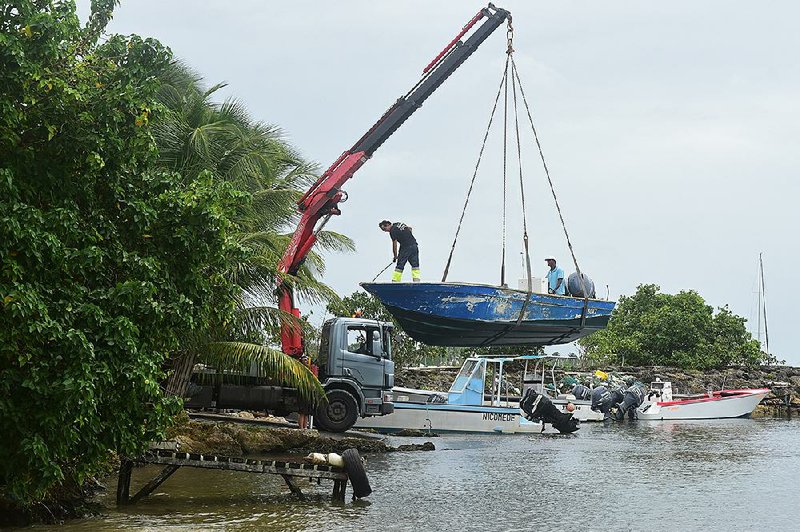Hurricane Maria grew into a Category 5 storm on Monday and pounded the small island of Dominica as it surged into the eastern Caribbean on Monday night, and forecasters warned it might become even stronger.
The storm was on a path that would take it near many of the islands already wrecked by Hurricane Irma and then on toward a possible direct strike into Puerto Rico on Wednesday.
Fierce winds and driving rain lashed the mountainous island for hours, causing flooding and tearing roofs from homes.
A series of Facebook posts by Dominica Prime Minister Roosevelt Skerrit captured the fury of the storm as it made landfall.
[HURRICANE TRACKER: Follow Maria’s projected path]
"The winds are merciless! We shall survive by the grace of God," Skerrit wrote at the start.
A few minutes later, he messaged he could hear the sound of galvanized steel roofs tearing off houses. He then wrote that he thought his home had been damaged.
A half-hour later, he said: "My roof is gone. I am at the complete mercy of the hurricane. House is flooding." Seven minutes later he posted that he had been rescued.
Late Monday, a police official, Inspector Pellam Jno Baptiste, said there were no immediate reports of casualties but it was still too dangerous for officers to do a full assessment as the storm raged outside.
"Where we are, we can't move," he said in a brief phone interview.
Dominica authorities had closed schools and government offices and urged people to move from dangerous areas to shelters.
"We should treat the approaching hurricane very, very seriously," the prime minister warned as the storm approached.
Officials in Guadeloupe said the French Caribbean island would experience extremely heavy flooding starting Monday afternoon, and they warned that many communities would be submerged overnight.
In nearby Martinique, authorities ordered people to remain indoors and said they should be prepared for power cuts and disruption in the water supply. All schools and nonessential public services were closed.
With Puerto Rico appearing destined for a hit, officials in the U.S. territory warned residents of wooden or otherwise flimsy homes to find safe shelter.
"You have to evacuate. Otherwise you're going to die," said Hector Pesquera, the island's public safety commissioner. "I don't know how to make this any clearer."
The U.S. territory on Monday imposed rationing of basic supplies including water, milk, baby formula, canned foods, batteries, flashlights and other items.
The U.S. National Hurricane Center called the storm "extremely dangerous," with maximum sustained winds of 160 mph late Monday. The eye was atop Dominica and about 270 miles southeast of St. Croix in the U.S. Virgin Islands. It was heading west-northwest at 9 mph.
Earlier in the day, the center had warned: "Maria is developing the dreaded pinhole eye."
That's a sign of an extremely strong hurricane likely to get even mightier, University of Miami hurricane researcher Brian McNoldy said.
Hurricane warnings were posted for the U.S. and British Virgin Islands, Puerto Rico, Guadeloupe, Dominica, St. Kitts, Nevis and Montserrat. A tropical storm warning was issued for Antigua and Barbuda, Saba, St. Eustatius, St. Maarten, Martinique and Anguilla.
Forecasters said storm surge could raise water levels by 6 to 9 feet near the storm's center. The storm was predicted to bring 10 to 15 inches of rain across some islands, with more in isolated areas.
The storm has hurricane-force winds that extend about 30 miles from the eye, and tropical storm force winds out as far as 125 miles. The current forecast track would carry it about 22 miles south of St. Croix in the U.S. Virgin Islands late today and early Wednesday, according to territorial Gov. Kenneth Mapp.
"We are going to have a very, very long night," Mapp said as he urged people in the territory to finish any preparations.
St. Thomas and St. John are still recovering from a direct hit by Hurricane Irma, which did extensive damage and caused four deaths on the two islands.
On Wednesday, Maria was expected to be near or over Puerto Rico, which was spared the full brunt of Irma, although much of the island had its power knocked out. Nearly 70,000 people remain without power, and Gov. Ricardo Rossello on Monday warned of another widespread power failure.
Officials said the Federal Emergency Management Agency was ready to bring drinking water and help restore power in Puerto Rico immediately after the storm.
Rossello said officials had prepared about 500 shelters capable of taking in up to 133,000 people in a worst-case scenario. There are still nearly 200 people in shelters from Hurricane Irma.
Farther north, long-lived Hurricane Jose continued to head northward off the U.S. East Coast, causing dangerous surf and rip currents. It wasn't expected to make landfall, but tropical storm watches were posted along the coast.
Jose was centered about 235 miles east-southeast of Cape Hatteras, N.C., and was moving north at 8 mph. It had maximum sustained winds of 75 mph.
The ocean washed over parts of North Carolina's Outer Banks as Hurricane Jose passed well to the east, and five people were knocked off a coastal jetty in Rhode Island by high surf caused by the storm. All five were hospitalized.
Information for this article was contributed by Ben Fox in Miami and Seth Borenstein of The Associated Press.
A Section on 09/19/2017
